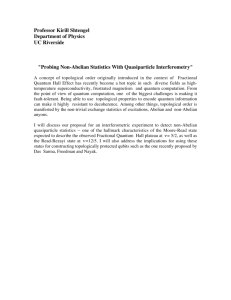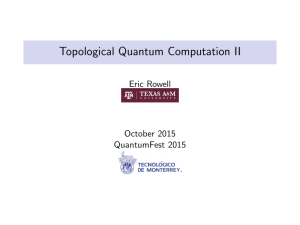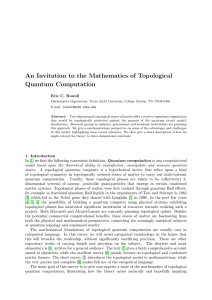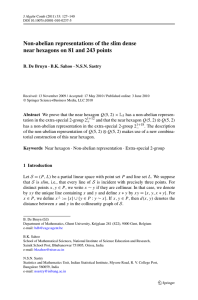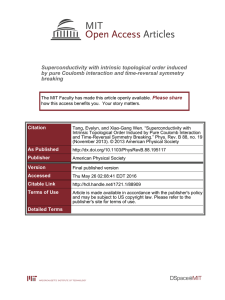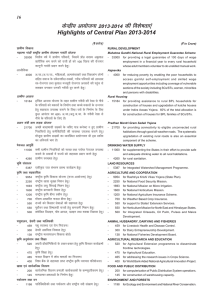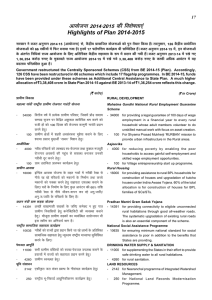Non-Abelian Anyon interferometry
advertisement
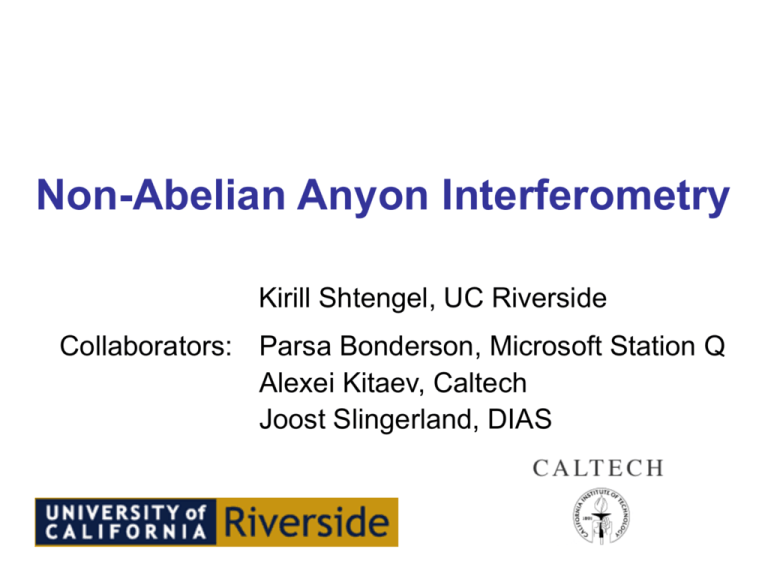
Non-Abelian Anyon Interferometry Kirill Shtengel, UC Riverside Collaborators: Parsa Bonderson, Microsoft Station Q Alexei Kitaev, Caltech Joost Slingerland, DIAS Exchange statistics in (2+1)D • Quantum-mechanical amplitude for particles at x1, x2, …, xn at time t0 to return to these coordinates at time t. Feynman: Sum over all trajectories, weighting each one by eiS. Exchange statistics: What are the relative amplitudes for these trajectories? Exchange statistics in (2+1)D • In (3+1)D, T −1 = T, while in (2+1)D T −1 ≠ T ! • If T −1 = T then T 2 = 1, and the only types of particles are bosons and fermions. Exchange statistics in (2+1)D: The Braid Group Another way of saying this: in (3+1)D the particle statistics correspond to representations of the group of permutations. In (2+1)D, we should consider the braid group instead: Abelian Anyons • Different elements of the braid group correspond to disconnected subspaces of trajectories in space-time. • Possible choice: weight them by different overall phase factors (Leinaas and Myrrheim, Wilczek). • These phase factors realise an Abelian representation of the braid group. E.g q = p/m for a Fractional Quantum Hall state at a filling factor ν = 1/m. • Topological Order is manifested in the ground state degeneracy on higher genus manifolds (e.g. a torus): m-fold degenerate ground states for FQHE (Haldane, Rezayi ’88, Wen ’90). Example (toy model) of Abelian Anyons : charge q - flux Φ composites (Wilczek, '82) The Aharonov - Bohm phase 2q qΦ qΦ 2qΦ (in the units c 1) E.g. for q e, Φ 2p/ne, the statistica l angle q 2π/n. Non-Abelian Anyons Exchanging particles 1 and 2: Exchanging particles 2 and 3: • Matrices M12 and M23 need not commute, hence Non-Abelian Statistics. • Matrices M form a higher-dimensional representation of the braid-group. • For fixed particle positions, we have a non-trivial multi-dimensional Hilbert space where we can store information The Quantum Hall Effect e2 h p q Eisenstein, Stormer, Science 248, 1990 “Unusual” FQHE states Pan et al. PRL 83,1999 Gap at 5/2 is 0.11 K Xia et al. PRL 93, 2004 Gap at 5/2 is 0.5K, at 12/5: 0.07K FQHE Quasiparticle interferometer Chamon, Freed, Kivelson, Sondhi, Wen 1997 Fradkin, Nayak, Tsvelik, Wilczek 1998 Measure longitudinal conductivity xx due to tunneling of edge current quasiholes n General Anyon Models (unitary braided tensor categories) Describes two dimensional systems with an energy gap. Allows for multiple particle types and variable particle number. 1. A finite set of particle types or anyonic “charges.” 2. Fusion rules (specifying how charges can combine or split). 3. Braiding rules (specifying behavior under particle exchange). There is a particle type I correspond ing to " vacuum." Each particle type a has a " charge conjugate" a that is the unique particle type which may fuse with a to give I . The fusion rules are specified as : where the integer N c ab ab N c is the number of c ab c channels for fusing a and b into c. Diagrammatically, this gives a set of allowed trivalent vertices : Associativity relations for fusion: [F abc d ef ] f Braiding rules: a b b R ab c * These are all subject to consistency conditions. a Consistency conditions A. Pentagon equation: Consistency conditions B. Hexagon equation: Topological S-matrix M ab S ab S II S Ia S Ib M ab 1 corresponds to Abelian braiding and M ab 1 iff the braiding is non - Abelian. Back to the experiment al setup : Need to calculate xx 1 Uq2ab ab tUt tM xxxx t11U1t 2t Re t cosU 2 2 2ab 2 * ab ab 2 1 22 1 2ab U1 ab 1 U 2 ab b i a e R ab 2 ab M ab ab R ab M ab e 2 iq ab xx t1 t 2 2 t1t 2 M ab cos q ab 2 argt2 / t1 2 is a parameter that can be experimentally varied. |Mab| < 1 is a smoking gun that indicates non-Abelian braiding. 5 / 2 is believed to be MR U(1) Ising U(1) is a familiar Abelian factor due to electric charge Ising particle types : I , , Fusion rules : I I I, I , I , I , , I 1 1 1 Monodromy : M 1 0 1 1 1 1 quasiholes carry anyonic charge : (e / 4, ) electrons carry anyonic charge : (e, ) n quasiholes carry anyonic charge : (ne / 4, ) for n odd (ne / 4, I or ) for n even Combined anyonic state of the antidot Adding non-Abelian “anyonic charges” for the Moore-Read state: Even-Odd effect (Stern & Halperin; Bonderson, Kitaev & KS, PRL 2006): 12 / 5 is believed to be RR 3 U(1) Pf3 U(1) Fib (Note : Fibonacci anyons can simulate a universal quantum computer.) Fib particle types : I , Fusion rules : I I I, I , I Monodromy : 1 1 M 2 1 where is the golden ratio ( 1 5 2 2 .38) quasiholes carry anyonic charge : (e / 5, ) electrons carry anyonic charge : ( e, I ) n quasiholes carry anyonic charge : (ne / 5, I or ) For 5 / 2 : n odd : xx t1 t 2 2 2 n even : xx t1 t 2 2 t1t 2 1 2 2 N cos np / 4 where N 0 for I and N 1 for For 12 / 5 (Bonderson , KS & Slingerlan d PRL 2006; Chung & Stone PRB 2006) : xx t1 t 2 2 t1t 2 2 2 2 N cos n4p / 5 where N 0 for Fibonacci charge I and N 1 for Note : 2 .38 Topological Quantum Computation (Kitaev, Preskill, Freedman, Larsen, Wang) 0 a b a c0 1 b c1 (Bonesteel, et. al.) Interferom eter Topological Qubit (Das Sarma, Freedman, Nayak) One (or any odd number) of quasiholes per antidot. Their combined state can be either I or , we can measure the state by doing interferometry: The state can be switched by sending another quasihole through the middle constriction. Topological Qubit (the Fibonacci kind) 12 / 5 qubit : the combined state of two antidots may be I or xx t1 t2 2 t1t2 2 2 2 N cos n4p / 5, N 0 (1) for I ( ) The two states can be discriminated by the amplitude of the interference term! Wish list Get experimentalists to figure out how to perform these very difficult measurements and, hopefully, • Confirm non-Ableian statistics. • Find a computationally universal topological phase. • Build a topological quantum computer. Conclusions If we had bacon, we could have bacon and eggs, if we had eggs… Part Two: Measurements and Decoherence: State vectors may be expressed diagrammatically in an isotopy invariant formalism: 1/ 4 * Normalization factors d c / d a d b that make the diagrams isotopy invariant will be left implicit to avoid clutter. Anyonic operators are formed by fusing and splitting anyons (conserving anyonic charge). For example a two anyon density matrix is: Traces are taken by closing loops on the endpoints: Mach-Zehnder Interferometer t j Tj * rj 2 rj t *j 2 t j rj 1 Applying an (inverse) F-move to the target system, we have contributions from four diagrams: Remove the loops by using: 0 to get… M ab S ab S 00 S 0 a S 0b … the projection: for the measurement outcome s , where Result: Interferometry with many b probes gives binomial distributions in p s for the measurement outcomes, and collapses the target onto fixed states with a definite s p value of . Hence, superpositions of charges a and a' survive only if: M ab M a 'b and only in fusion channels corresponding to difference charges e with: M eb 1
